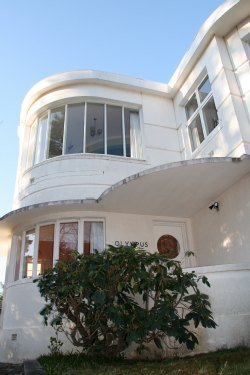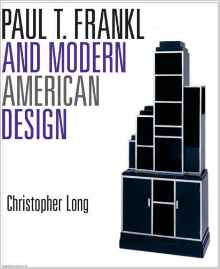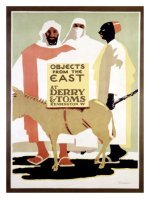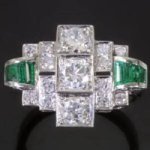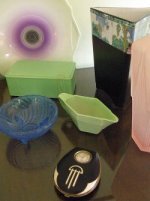Art Deco Architecture
Some links from this site lead to third parties who pay us a commission if you buy something. This allows us to keep providing the information on this site free of charge!
Although Paris was the true home of Art Deco, and the origins of Art Deco architecture can be found in the pavilions of the 1925 Exposition, it was in America that Art Deco style was expressed in concrete form in the buildings of the 1920s and 1930s.
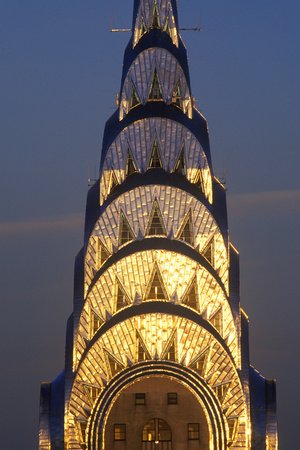 Chrysler Building - New York
Chrysler Building - New YorkThe pavilions of the 1925 Paris "Exposition Internationale des Arts Décoratifs et Industriels Modernes" which were only designed to last for six months would remain the major expression of Art Deco Architecture in France.
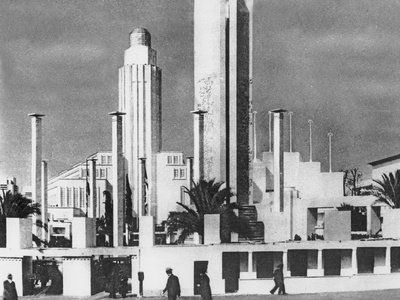 Pavilions at the 1925 Paris Expo
Pavilions at the 1925 Paris ExpoParis led the world in Art Deco Fashion, jewelry, interior design, furniture and decorative objects which the world discovered through the 1925 Paris Expo.
The style found artistic expression in the skyscrapers, movie theaters, cocktail bars and hotels of America.
Although America was not represented at the Expo, many American architects and designers would have attended and returned inspired to create the first Art Deco architecture.
In addition, many architects and designers fled to the USA during the first world war and in the years immediately afterwards so the new designs which were born in Europe soon spread to the rest of the world.
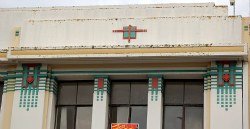 Art Deco detail in Napier, New Zealand by Fiona Johnson
Art Deco detail in Napier, New Zealand by Fiona JohnsonDecorative or Streamlined Architectural Elements
There were two main phases of Art Deco architectural development. At first it was a decorative element, adorning buildings with two dimensional flat representations of the human form, flowers, animals, the geometric and abstract shapes taken from Cubism, and the ziggurat from Egyptian, Mayan or Aztec architectural forms.
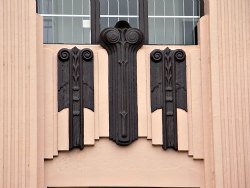 Art Deco Architectural Detail on a Bank in Richmond, NSW, Australia
Art Deco Architectural Detail on a Bank in Richmond, NSW, AustraliaIn the 1930s came the more curvi-linear asymmetric streamlined designs which were used for more domestic types of architecture, homes and small business, as well as underground stations, and even zoo exhibits such as the penguin house at London Zoo and the now demolished Monkey House at Melbourne Zoo.
Of course, some buildings took inspiration from both camps. The Cincinnati Union Terminal by Fellheimer & Wagner, 1929-33 featured a streamlined domed interior, and a dramatic stepped exterior with a huge numberless clock.
The interior expressed the colourful decorative elements of Art Deco, namely a bright yellow – orange striped dome and a glass mosaic mural by Winhold Reiss completed the design.
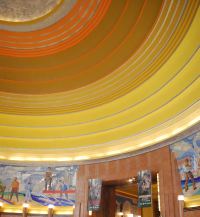 Interior of Cincinnati Union Terminal - Photo by Glenda Steain
Interior of Cincinnati Union Terminal - Photo by Glenda SteainArt Deco Architecture
The Skyscraper Aesthetic
Skyscrapers such as the Empire State Building, the Chrysler Building and the Rockefeller Center have become major Art Deco icons which have inspired artists, photographers and even textile designers to the present day.
In the America of the 1920s they were a symbol of progress, power, commercialism and wealth and gave hope to a struggling population still recovering from the effects of war.
Soon the skylines of many major cities from Shanghai to Rio had their own soaring Art Deco skyscrapers.
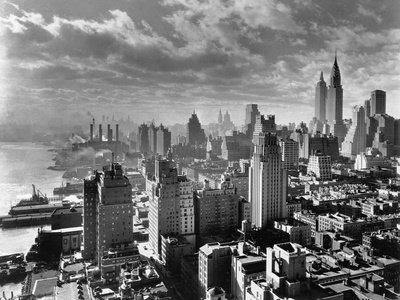 Manhattan 1931
Manhattan 1931The aesthetics of skyscraper design took inspiration not just from the elite Paris designs but from the ancient cultures of the Aztecs, the Egyptians, Africa, and even Hollywood.
Lobbies and interiors took on the glamour of Hollywood sets, with gleaming marble, black and mirrored walls, glass and steel. Black and white featured prominently, but with striking accents of orange, red or deep green.
The style was soon taken up by cocktail bars, speakeasies, movie theaters, and hotels, such fantasy pleasure palaces filling the demand for an escape from the pressures of everyday life.
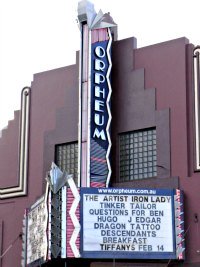 Hayden Orpheum Picture Palace, Sydney
Hayden Orpheum Picture Palace, SydneyPicture houses in particular took inspiration from the 1922 discovery of
the tomb of King Tut - Tuthankhamoun, with brightly coloured opulent
decoration in bright colours, ziggurats, columns, scarabs and sunbursts.
New York clubs sprang up in the Prohibition, which only served to
glamorise drinking alcohol with the chic sophistication of black chrome,
glass and mirrors.
Skycrapers' Influence on Other Arts
The skyscraper aesthetic filtered down into other decorative forms such as furniture - Paul Frankl produced a range of "Skyscraper furniture" from 1925-30 with multi-functional units which were functional as well as stylish. Eventually, the skyscraper aesthetic was to inform all kinds of domestic objects from radios to toasters, from ceramics to glass to jewelry.
Art Deco Architecture
Streamlined Moderne
Streamlined Moderne style was the other side of the Art Deco architecture coin. What we might call today, minimalism. It has its roots in the more avant-garde movements, such as Italian Futurism, Russian Constructivism, the Bauhaus, and De Stijl schools. Largely kept in the background at the Paris Expo in 1925, it was nevertheless represented with Le Corbusier's Pavilion d'Esprit Nouveau and the Russian pavilion by Constanin Melnikkov.
"Modern decorative art has no decor" - Le Corbusier
Beauty should be in the form and structure and needs no adornment, was the prevailing ethos during the 1930s when streamlined moderne really took off.
Streamlining was a reaction to the new age of technology, with new materials such as steel. Walls were pure white, and curved.
Buildings were asymmetrical and geometric. Interiors were an integral part of the design with built in cupboards, tubular furniture and curved white walls, circular windows and balconies to mimic the popular ocean liners. Houses such as these appear in coastal towns all over the world, their windows like port holes and their curved streamlined shapes evoking the speed and glamour of the new shipping lines, airlines and trains.
Streamlined moderne style culminated in the 1939 New York World Fair which was crowned by the enduring image of the Trylon & Perisphere by Wallice Harrison and J. Andre Fouilhoux. Held at Flushing Meadow, New York, the theme of the fair was “The World of Tomorrow” a vision of science and technology of the future. One of the main “futuristic” exhibits was the television.
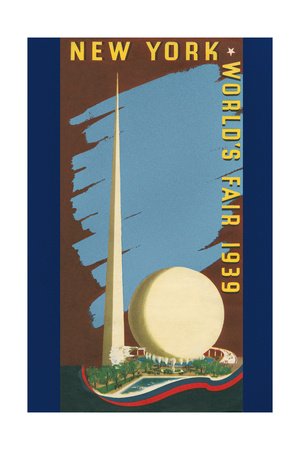 Trylon and Perisphere
Trylon and PerisphereMajor architects of streamlined moderne style were Le Corbusier, Frank Lloyd Wright, and Norman Bel Geddes who was the main impetus behind the development of this type of Art Deco architecture in America.
Check out lots more information about these different types of Art Deco architecture:
For Art Deco Books on Architecture, click here
Napier Earthquake creates Art Deco Town
Etsy has a surprisingly good range of Art Deco furniture, interior decor, art and prints, 1920s and 1930s fashion, accessories, jewellery and Bakelite. Click the banner to explore.
Join our Facebook Page so you never miss a thing!
Like this Page
- Decolish Home
- Architecture
